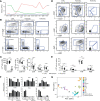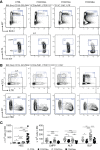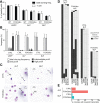FOXO Dictates Initiation of B Cell Development and Myeloid Restriction in Common Lymphoid Progenitors
- PMID: 35603175
- PMCID: PMC9116193
- DOI: 10.3389/fimmu.2022.880668
FOXO Dictates Initiation of B Cell Development and Myeloid Restriction in Common Lymphoid Progenitors
Abstract
The development of B cells relies on an intricate network of transcription factors critical for developmental progression and lineage commitment. In the B cell developmental trajectory, a temporal switch from predominant Foxo3 to Foxo1 expression occurs at the CLP stage. Utilizing VAV-iCre mediated conditional deletion, we found that the loss of FOXO3 impaired B cell development from LMPP down to B cell precursors, while the loss of FOXO1 impaired B cell commitment and resulted in a complete developmental block at the CD25 negative proB cell stage. Strikingly, the combined loss of FOXO1 and FOXO3 resulted in the failure to restrict the myeloid potential of CLPs and the complete loss of the B cell lineage. This is underpinned by the failure to enforce the early B-lineage gene regulatory circuitry upon a predominantly pre-established open chromatin landscape. Altogether, this demonstrates that FOXO3 and FOXO1 cooperatively govern early lineage restriction and initiation of B-lineage commitment in CLPs.
Keywords: B cell; FOXO (forkhead box protein O); gene regulation; lineage commitment/specification; myeloid restriction.
Copyright © 2022 Peña-Pérez, Kharazi, Frengen, Krstic, Bouderlique, Hauenstein, He, Somuncular, Li Wang, Dahlberg, Gustafsson, Johansson, Walfridsson, Kadri, Woll, Kierczak, Qian, Westerberg, Luc and Månsson.
Conflict of interest statement
The authors declare that the research was conducted in the absence of any commercial or financial relationships that could be construed as a potential conflict of interest.
Figures







References
Publication types
MeSH terms
Substances
LinkOut - more resources
Full Text Sources
Molecular Biology Databases
Research Materials
Miscellaneous

